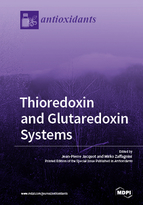Thioredoxin and Glutaredoxin Systems
A special issue of Antioxidants (ISSN 2076-3921). This special issue belongs to the section "Antioxidant Enzyme Systems".
Deadline for manuscript submissions: closed (30 September 2018) | Viewed by 79174
Special Issue Editors
Interests: carbon metabolism; redox homeostasis; thiol-dependent post-transalational modifications
Special Issues, Collections and Topics in MDPI journals
Special Issue Information
Dear Colleagues,
The thioredoxin and glutaredoxin systems are the two key regulators of the redox status of the cell. They can back up one another in a wide variety of reactions including ribonucleotide reduction, historically the first reaction that led to their discovery. In addition they are required for sulfate assimlation, the repair of oxidized proteins and lipids, peroxide detoxification, the regulation of transcription factors and the regulation of key enzymes of the CO2 fixation pathways in plants. Most organisms contain several genes coding for thioredoxin or glutaredoxin ranging from a handful in bacteria and mammals to ca forty genes each in photosynthetic eukaryotes. Likewise, the mode of reduction of these proteins is very varied, glutaredoxins being generally reduced by glutathione (from NADPH and glutathione reductase) and thioredoxin by a variety of reductases, either flavoenzymes containg selenocysteine or not and dependent on NADPH, or ferredoxin dependent enzymes in higher plants. Some microrganisms (e.g., Trypanosoma) contain alternative systems called tryparedoxins structurally related to the thioredoxin fold but with unique properties. Recent developments in the study of these redox systems concern the requirement for glutaredoxin in some steps of iron sulfur centers assembly and the mechanisms of aging in various biological organisms. Of particular interest, the combination of mutations on several of these genes leads to lethal phenotypes in many organisms and some genetic diseases result from similar mutations.
This Special Issue welcomes original research papers and reviews to expand our understanding and perspective on all aspects linked to redox homeostasis via the thioredoxin and glutaredoxin systems. Special interests include structure function analysis of the components of these systems, the roles of glutaredoxins in iron sulfur assembly, the role of thioredoxin in aging, the generation and use of redox fluorescent probes and of knock-out mutants of selected targets. Studies concerning thioredoxin or glutaredoxin-dependent enzymes are also most welcome as well as phylogenetic studies concerning these systems and their development.
Prof. Jean-Pierre JacquotGuest Editor
Manuscript Submission Information
Manuscripts should be submitted online at www.mdpi.com by registering and logging in to this website. Once you are registered, click here to go to the submission form. Manuscripts can be submitted until the deadline. All submissions that pass pre-check are peer-reviewed. Accepted papers will be published continuously in the journal (as soon as accepted) and will be listed together on the special issue website. Research articles, review articles as well as short communications are invited. For planned papers, a title and short abstract (about 100 words) can be sent to the Editorial Office for announcement on this website.
Submitted manuscripts should not have been published previously, nor be under consideration for publication elsewhere (except conference proceedings papers). All manuscripts are thoroughly refereed through a single-blind peer-review process. A guide for authors and other relevant information for submission of manuscripts is available on the Instructions for Authors page. Antioxidants is an international peer-reviewed open access monthly journal published by MDPI.
Please visit the Instructions for Authors page before submitting a manuscript. The Article Processing Charge (APC) for publication in this open access journal is 2900 CHF (Swiss Francs). Submitted papers should be well formatted and use good English. Authors may use MDPI's English editing service prior to publication or during author revisions.
Keywords
- Thioredoxin
- Glutaredoxin
- Redox regulation
- Thioredoxin reductase
- Glutathione
- Reactive oxygen species (ROS)
- Reactive nitrogen species (RNS)
- CO2 fixation
- Chloroplast
- Iron sulfur assembly
- Mitochondria








